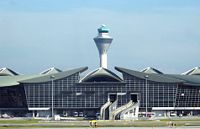Kuala Lumpur International Airport
| Kuala Lumpur International Airport Lapangan Terbang Antarabangsa Kuala Lumpur 吉隆坡國際機場 கோலாலம்பூர் சர்வதேச விமான நிலையம் |
|||
|---|---|---|---|
|
|
|||
| IATA: KUL – ICAO: WMKK | |||
| Summary | |||
| Airport type | Public | ||
| Operator | Malaysia Airports (Sepang) Sdn Bhd | ||
| Location | Sepang, Kuala Lumpur, Malaysia | ||
| Elevation AMSL | 71 ft / 21 m | ||
| Website | |||
| Runways | |||
| Direction | Length | Surface | |
| ft | m | ||
| 14L/32R | 13,530 | 4,124 | Concrete |
| 14R/32L | 13,288 | 4,056 | Concrete |
| Statistics (2007) | |||
| Passenger movements | 26,938,970 | ||
| Airfreight movements in tonnes | 649,197 | ||
| Aircraft movements | 193,982 | ||
Kuala Lumpur International Airport (IATA: KUL, ICAO: WMKK) commonly known as KLIA is one of Asia's major aviation hubs, along with Bangkok's Suvarnabhumi Airport, Hong Kong International Airport and Singapore Changi Airport. It is also Malaysia's main international airport. It is situated in Sepang district, in the south of the state of Selangor, about 50 kilometres (31 mi) from the capital city, Kuala Lumpur. Built at a cost of some US$3.5 billion[1].
Kuala Lumpur International Airport is capable of handling 35 million passengers and 1.2 million tonnes of cargo a year in its current phase. It is currently ranked as the 13th busiest airport in the world by international passenger traffic in 2007, and is one of Asia's busiest airport where it has handled 26,938,970 passengers in the year of 2007, a 13.0% increase over 2005 fiscal year. In the same year, Kuala Lumpur International Airport has handled 677 446 metric tonnes of cargo or 3.6% increase in volume over year 2005. The increase in cargo volume made Kuala Lumpur International Airport entry to being one of the busiest airport by cargo traffic, ranked 30th among all other airports.[2]
The airport is operated by Malaysia Airports (MAHB) Sepang Sdn Bhd and is the airline hub or home base for Malaysia Airlines, MASkargo, AirAsia and AirAsia X. KLIA is also the stopover point for the kangaroo route for Malaysia Airlines.
Kuala Lumpur International Airport is serving Klang Valley Metropolitan Region, Greater Klang Valley, Shah Alam, Malacca, Negeri Sembilan, Selangor and South Perak. With the large catchment area, the airport became one of the key economic strength for the nation, where it is well connected expressways to all parts of Peninsular Malaysia, some of the highly industralized areas like Shah Alam and the information and communications technology hub, Multimedia Super Corridor. It is one of the important components in the economy of Malaysia as the airport is the main import-export center for the country.
The IATA airport code, KUL was inherited from the previous international gateway for Malaysia, Subang International Airport, which currently handles only turboprop aircraft, general aviation and houses a military air base.
Contents |
History
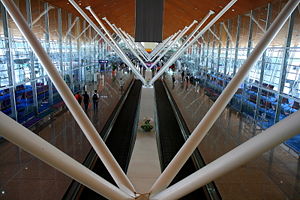
The planning of KLIA began in 1990 when the government decided that the existing Subang International Airport (now Sultan Abdul Aziz Shah Airport) could not handle future demand. Malaysia's Prime Minister Mahathir bin Mohamad was a prime driver behind the project, which was seen as an important component of the Multimedia Super Corridor.
The decision was controversial. The location, over 51 km from Kuala Lumpur, was viewed as inconvenient; the cost ballooned from original estimates; critics alleged that, contrary to the government's assertions, Subang could still be expanded. Indeed, work on Subang continued simultaneously with KLIA's construction. Subang's new Terminal 3 was opened in December 1993 and Terminal 2 was refurbished in 1995, only three years before KLIA's opening.[1]
With the airport site spanning 100 km²[1], it is one of the largest airport sites in the world. It is built on a piece of agricultural land and required no demolition of private property. The master plan of Kuala Lumpur International Airport involves constructing five runways, and two terminals accompanied by two satellite terminals for each terminal over three phases.[3] Phase One development includes constructing one main terminal accompanied by one satellite terminal that is enough to accommodate 25 million passengers and dual full service runways. Under the implementation of Phase One, sixty contact piers, twenty remote parking bays with eighty aircraft parking positions, four maintenance hangars and fire stations will be built. Implementation of phase two and three will be expansions of the airport to include increasing number of passengers.[3]. Ultimately, the airport will be able to handle 100 million passengers per annum once all three phases are implemented.[3]
With the workforce of 25,000 workers working 24 hours a day, the airport was built within four and half years[1]. The airport was officially inaugurated on June 27, 1998, a week ahead of Hong Kong International Airport, but flights were shifted from Subang only three days later on June 30 in time for the 1998 Commonwealth Games. The first domestic arrival was Malaysia Airlines flight MH1263 from Kuantan (Kuantan Airport) at 7.10am and first international passenger jet arrival was Malaysia Airlines flight MH188 from Malé (Malé International Airport) at 7.30am while the first domestic departure was Malaysia Airlines flight MH1432 to Langkawi (Langkawi International Airport) at 7.20am and first international passenger jet departure was Malaysia Airlines flight MH84 to Beijing (Beijing Capital International Airport) at 9am.[4]
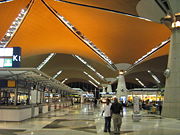
The inauguration of the airport was marked with problems. Aerobridge and bay allocation systems broke down, queues formed throughout the airport, and baggage handling broke down, with lost bags and waits of over five hours.[5] Most of these issues were sorted out eventually, but the baggage handling system continued to be plagued with problems, and it was finally put up for a new complete replacement tender in 2007.
The airport also had to contend with the East Asian financial crisis, SARS and Bird Flu Epidemic (Avian Flu) which decimated passenger traffic in Malaysia and the region. Passenger growth was negative during the financial crisis and airlines that had started flights to KLIA including All Nippon Airways, British Airways, Lufthansa and Northwest Airlines, terminated their services due to unprofitability. The first phase of the airport was designed with a capacity of 25 million passengers per year but on the first full year of operations in 1999, it saw only 13.2 million.[6] However, traffic did eventually increase with 21.1 million passengers recorded in 2004 and 23.2 million in 2005 — although this, too, fell short of the original estimate of 25 million by the year 2003.
The name Kuala Lumpur International Airport was previously used as an alternative name for the Sultan Abdul Aziz Shah Airport (SZB) in Subang.
Expansion and Developments
Plans
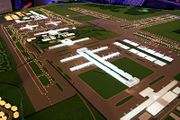
Under the new Kuala Lumpur International Airport Masterplan, a new runway and a new satellite building will be constructed to accommodate the increasing number of passengers. The airport Phase 2 development plan is to handle 40 million (▲5 Million) passengers per year by 2008 with the expansion of low cost carrier terminal. For phase 3, the airport will expand to handle 75 million (▲35 million) passengers per annum with the construction of a new satellite terminal and replacement of current low cost carrier terminal with a new low cost carrier terminal that capable of handling 30 million passengers alone. Phase 4, the airport will be capable to 130 million passengers per annum by 2020.
With the slight modification of the masterplan, the future Terminal 2's satellite terminal will be combined into one satellite terminal. The expansion of Terminal 2's satellite terminal will be exactly the same as Terminal 1's satellite terminal, where initially the satellite terminal will have four arms, and another four arms when the terminal reached its capacity. There is sufficient land and capacity to develop facilities to handle up to 130 million passengers a year, five runways by the year 2020 and two mega-terminals, each linked with satellite terminals.[3] The airport's vicinity will include hiking trails for jet-lagged travelers, golf courses, convention center, a theme park, a shopping center, hotels, and a wetlands nature preserve. Sepang International Circuit, which hosts Formula 1 and MotoGP races, is also nearby. There has also been a proposal for a monorail link to the F1 circuit. The development plan is due to be ready by April 2008.[7]
In November 2006, the Malaysian government announced that it had approved in principle the construction of a rail link between the main terminal building and the low-cost carrier terminal. Construction was scheduled to begin in 2007. There were however no details of which company would carry out the project, nor was there an indication that it would be directly connected to the existing airport high-speed train Express Rail Link.
| Summary of Kuala Lumpur International Airport Masterplan | ||||
|---|---|---|---|---|
| Phase | Year | Description | ||
| Phase 1 | 1998 | Initial Capacity of 25 million Passenger Per Annum | ||
| 2006 | Capable of Handling 35 million Passengers per annum with the construction of Low Cost Carrier Terminal | |||
| Phase 2 | 2008 | Expansion of Low Cost Carrier Terminal to accommodate 40 Million Passengers per annum | ||
| Phase 3 | 2012 | New Low Cost Carrier Terminal will be constructed to accommodate additional 30 million (55 million) passengers Per Annum, Current Low Cost Carrier Terminal converted to cargo usage. | ||
| Not fixed | Satellite Terminal B will be constructed to handle maximum of 75 million passengers. (One terminal accompanied by 2 satellite terminal and one low cost carrier terminal) | |||
| Phase 4 | Not fixed | Terminal 2 and Satellite Terminal C will be constructed so that the airport is capable to handle 120 million passengers. | ||
LCCT Extension and New LCCT
| Operational Statistics[8] | |||
|---|---|---|---|
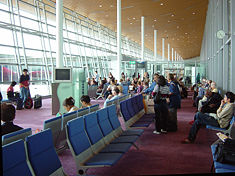 |
|||
| Year | Passenger movements |
Airfreight movements (tonnes) |
Aircraft movements |
| 1998 | 6,524,405 | 156,641 | 64,123 |
| 1999 | 13,172,635 | 417,068 | 116,589 |
| 2000 | 14,732,876 | 510,594 | 109,925 |
| 2001 | 14,538,831 | 440,864 | 113,590 |
| 2002 | 16,398,230 | 527,124 | 127,952 |
| 2003 | 17,454,564 | 586,195 | 139,590 |
| 2004 | 21,058,572 | 651,747 | 164,483 |
| 2005 | 23,213,926 | 653,654 | 182,537 |
| 2006 | 24,570,385 | 677,446 | 183,869 |
| 2007 | 26,938,970 | 649,197 | 193,982 |
With an increasing number of passengers using the Low Cost Carrier Terminal, Malaysia Airports Holding Berhad (MAHB), the company managing KLIA has approved Low Cost Carrier Terminal (LCCT) expansion beginning early 2007 to accommodate more passengers as the current LCCT is nearly in full capacity. The expansion of LCCT also shows the support for launch of Malaysia's first long haul low cost carrier, AirAsia X by making the terminal able to accommodate wide-bodied aircraft that are used by AirAsia X[9] However, the Low Cost Carrier Terminal is a temporary solution for budget travellers, MAHB has submitted a proposal to the Transport Ministry to build a new, permanent LCC hub in between the main terminal building and satellite building A to replace the present Low Cost Carrier terminal.[10]
The airport operator has announced that the construction works for the extension of LCCT will begin in March 2008 and expected to complete by December 2008. The capacity for the LCCT will increase from 10 million passengers a year to 15 million passengers a year. A proposal for a more permanent building to house a new LCCT has been submitted and expected to have a capacity for 30 million passengers a year. It is also expected that the new LCCT will be completed by 2011 to 2012[11]. It is expected that the current LCCT will be converted in to a cargo hub once the new terminal is completed.[12] The RM124 million LCCT expansion project tender was won by Fajarbaru Builder Group Bhd and construction work is expected to begin immediately.[13]
The airport operator has announced that the construction of a permanent LCCT will commence sometime in 2008 although the site has yet to be finalized. It is expected that the permanent LCCT will have a design capacity of 30 to 35 million passengers per annum.[14]
A380 Upgrades
The operator of Kuala Lumpur International Airport, Malaysia Airports Holding Berhad, had spend about RM135 million (approx US$39 million) to upgrade facilities at the KL International Airport (KLIA) in Sepang to accommodate the Airbus A380. Upgrading works started on April 3, 2006 and was completed by May 28, 2007. Works include the provision of shoulders on both sides of the two existing runways of 15 meters as well as the taxiways, building additional aerobridges at the three departure halls, namely C17, C27 and C37, and enhancing the mezzanine lounges for upper deck passengers of the aircraft at the departure halls.[15]
Operations and infrastructure
KLIA features a number of modern design features that assist in efficient operation of the airport.
Terminals
The Passenger Terminal Complex (PTC) was built with an emphasis on allowing natural light into the building. Thus, there is a huge expanse of glass throughout the building, and the spectacular roof has cut-outs for natural light to filter in. The PTC comprises three buildings - the Main Terminal Building, the Satellite Building and the Contact Pier. Besides the 80-room hotel at the Satellite Building, there is a 450-room 5-star Pan Pacific KLIA hotel a 10 minute (indoor) walk away. Shopping spots are available in an area encompassing 85,000 square metres. Currently, the retail space at the Kuala Lumpur International Airport stands at 63,644 square metres (685,060 sq ft). The airport operator plans to increase the retail space to 103,251 square metres (1,111,380 sq ft), an 62.2% increase in retail space. Malaysia Airports's retail arm Eraman will boost retail shops to 277 from 242 and add more food and beverage outlets to 99 from 88 presently.[16]
Main terminal building and contact pier
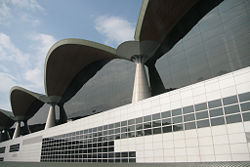

The Main terminal building or Terminal 1 is located in between the two runways. The building consist of 39 square roof units, which enables future expansion of the building. There are a total of 216 check-in counters, located in 6 different islands, identified by the letters A – M (excluding I). Multi check-in services are available, designed for the use of all passengers arriving, departing or in transit. On 2 February, 2007, Malaysia Airports introduces 12 integrated self check-in kiosks (CUSS) for passengers. The first airline to use that system is KLM. [17]A further 24 kiosks will be added later by the airport operator[18] [19]
The contact pier is the rectangular shaped terminal that is connected to the Main Terminal Building which serves as the domestic terminal of KLIA. It is currently the preferred terminal for Malaysia Airlines' domestic flights, however, it no longer caters the low-cost carriers' departing and arriving passengers. At the north side of the pier, it can only accommodate narrow-bodied aircraft. In contrast, the south side of the contact pier can accommodate B737 and B747 or similar sized aircraft.
The Malaysia Airports Holding Berhad derives 65% of its total annual revenue from non-aeronautical sources, with 35% from commercial space rental and a percentage of sale receipts . There were plans to increase and maximize the Main Terminal Building's and Contact Pier's retail area however, the plan was postponed due to Visit Malaysia Year 2007.[20].
The gates in Main Terminal Building's contact pier has alphabet prefix of A, B, G and H.
Satellite terminal A

The 143,404 square metres (1,543,590 sq ft) satellite building accommodates international flights departing and arriving at KLIA. Passengers have to travel to the satellite building via the Aerotrain. There is a wide array of duty-free shops and prestige brand boutiques in the satellite building. This includes international brands such as Burberry, Harrods, Mont Blanc, Salvatore Ferragamo and recently, Mango has opened its first boutique at an airport in the Asian region. Among all international labels available within the terminal, some boutiques such as Harrods are only available in the airport. Liquor and perfumes are particularly popular, accounting for over half of total retail sales, followed by watches and tobacco products. A number of restaurants and international airlines' lounges are available as well as an Airside Transit Hotel.
Within the terminal, wireless internet (Wifi) is provided free of charge. The terminal also has prayer rooms, showers and massage service. Various lounge areas are provided, some including children's play areas and movie lounge, broadcasting movie and sport channels such as Star Movies.[21] The terminal also features a natural rainforest in the middle of the terminal, exhibiting the Malaysian forests.
Under Malaysia Airports Berhad retail optimisation plan, the retail space in satellite terminal A will be further optimized to increase its revenue derived from commercial space rental and a percentage of sale receipts to 50% by year 2010 which currently stands at 35%. Some notable improvements that will be seen after the refurbishments will be the Jungle Boardwalk which will be the first of its kind in the world and larger mezzanine floor to accommodate F&B outlets and viewing galleries.[22].
The gates in Satellite Terminal A have the prefix C.The Satellite A terminal has 27 boarding gates altogether.
Low cost carrier terminal
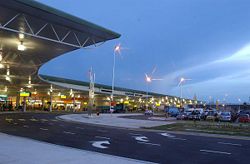
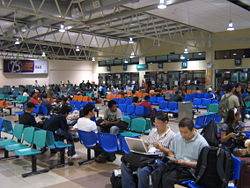
The first purpose built Low Cost Carrier Terminal (LCCT) was specifically built at KL International Airport to cater to the growing passengers of the low cost airlines, especially the passengers of Malaysia's "no-frills" airline, AirAsia. Construction of the LCC Terminal was on a fast-track basis beginning June 2005 at an approximate cost of RM 108 million. [23]
The 35,290 square-meter terminal is designed and built to suit the low cost carrier (LCC) business model that requires only basic terminal amenities. In order to offer lower landing fees, handling fees and airport taxes, it cuts back on amenities such as aerobridges, elaborate physical structures and decorations in the passenger terminal building. There is no transfer facility at the LCCT. Passengers who need to make transfers need to clear immigration, collect their luggage, clear customs, make their way to the main terminal and re-checkin with the respective airline.
The LCCT is located on the opposite side of the apron from the Main Terminal Building, near the air cargo area. By road, the LCCT is about 20 km from the Main Terminal Building.
However, the current Low Cost Carrier Terminal is a temporary solution for the increasing demand of no-frilled airline passengers. Therefore, Malaysia Airports Holding Berhad has incorporated the plans to build a new permanent LCC terminal which can accommodate 30 million passengers per annum[14] . This airport was the first airport to have separation between normal carriers and low cost carrier.
The gates in LCCT have alphabet prefix of P and T.
Kuala Lumpur City Air Terminal
Kuala Lumpur City Air Terminal, or KL CAT located at KL Sentral is a virtual extension of Kuala Lumpur International Airport where city check-in services are provided. Kuala Lumpur City Air Terminal is recognized by International Air Transport Association which carries IATA designation XKL. Currently there are only 4 airlines providing city check-in services, they are Cathay Pacific, Emirates Airline, Malaysia Airlines and Royal Brunei Airlines. However, the situation is due to be changed as 10 SITA's AirportConnect CUTE (Common Use Terminal Equipment) were installed on 10 check-in desks in KL CAT that enables all airlines to offer city check-in service for their passengers. [24]. Apart from providing check-in services, the virtual terminal operator, Express Rail Link Sdn Bhd which operates KLIA Express is planning to roll out baggage check-out service in January 2008 whereby passengers only collect their baggage and declare taxable items in Kuala Lumpur City Air Terminal. [25]
Awards and recognitions
Since its inauguration in year 1998, it has won numerous awards from international organizations around the world such as Skytrax and International Air Transport Association.
KLIA's commitment to promote environment responsibility for all local and foreign travellers was recognized by Green Globe, which is the first and only airport in the world to receive Green Globe certificate in year 2004 onwards.[26]
Since its inauguration on 27 June,1998, the airport has won awards. With its continuous effort to provide excellent services to passengers, the airport has emerged as one of the top five airports in the world.
In 2007, KLIA was rated the best airport in the world for 15-25 million passengers with Third Best Airport in Asia Pacific and Worldwide for the year of 2006. The award was organised by Airports Council International Airport Service Quality (ACI-ASQ)[27]. While in the 2007 Skytrax Airport of the Year awards, it finished fifth behind Hong Kong International Airport, Incheon International Airport, Singapore Changi Airport and Munich Airport.[28] In the 2008 Skytrax Airport of the Year Awards, it moved up a place to fourth in the World's Best Airport for the year 2008.[29]
In 2008, KLIA was honored again with the best airport in the world for 15-25 million passengers category n the Airport Council International's (ACI) Airport Services Quality Awards 2007. KLIA also improved its ranking this year for Best Airport Worldwide and Best Airport Asia Pacific by coming in second behind Seoul's Incheon International Airport[30], beating Singapore Changi Airport and Hong Kong International Airport which are leaders in service excellence.[31]
Apart from these, Kuala Lumpur International Airport is the first airport in the world to be accredited with Airport Service Quality (ASQ) Assured certificate from Airports Council International (ACI)[32]
Ground transportation
Inter-terminal transportation
Terminals of Kuala Lumpur International Airport are well connected with KLIA Automated People Mover (Aerotrain), a three-car driverless train that runs on elevated rail and under the taxiways, and also bus system.

- Main Terminal Building – LCCT
- The LCCT is connected with the Main Terminal Building with a NadiKLIA bus for RM1.50. The Malaysian government announced in November 2006 that it had approved in principle the construction of a rail link between the Main Terminal Building and LCCT. However, the construction is pending until the new LCCT hub complex is fully constructed by 2010.
- Main Terminal Building – Satellite Terminal A
- The Main Terminal Building and Satellite Building are connected by Aerotrain at three to five minute intervals. The journey between terminals takes under two minutes, and each 250-person capacity train is able to transport 3,000 passengers per hour per direction with the maximum speed being 56 km/h (35mp/h). This is a complimentary service for all passengers traveling to/from Satellite Terminal
On November 25 2008, the train manufacturer and airport operator announce a deal to purchase 3 new vehicles plus a spur line to a new Operations, Maintenance and Storage Facility worth 45 million euros. The new system is expected to be fully functional by 2011.[33]
Rail
- Main articles: KLIA Ekspres, KLIA Transit,KLIA ERL station,KL Sentral
| Infrastructure | ||
|---|---|---|
| Passenger terminal buildings | ||
| Totals | (current) | (After LCCT Relocation) |
| Floor area | 514,694 m² | Unknown m² |
| Handling capacity | 35 million passengers | 55 million passengers |
| Parking bays | 46 (aerobridge) 68 (contact) 21 (remote) |
LCCT Relocation Plan yet to be unveiled |
| Main Terminal Building 1 & Contact Pier | ||
| Opened | 27 June 1998 (operational) | |
| Floor area | 336,000 m² | |
| Handling capacity | 5 million passengers per annum | |
| Parking bays | 20 (aerobridge) 23 (remote) |
|
| Satellite Terminal A | ||
| Opened | 27 June 1998 (operational) | |
| Floor area | 143,404 m² | |
| Handling capacity | 20 million passengers per annum | |
| Parking bays | 26 (aerobridge) 15 (remote) |
|
| Low Cost Carrier Terminal | ||
| Opened | 23 March 2006 (operational) | |
| Floor area | 35,290 m² | |
| Handling capacity | 10 million passengers (Current) 15 million after LCCT expansion |
|
| Parking bays | 30 | |
| New Low Cost Carrier Terminal | ||
| Opened | Under Planning | |
| Floor area | Under Planning | |
| Handling capacity | 30 million |
|
| Parking bays | Under Planning | |
| Bunga Raya Complex | ||
| Opened | 27 June 1998 (official) | |
| Floor area | ||
| Handling capacity | ||
| Parking bays | 1 | |
Kuala Lumpur International Airport can be reached by the KLIA Ekspres and the KLIA Transit. KLIA Ekspres provides a non-stop express train service to the KL City Air Terminal (KL CAT) which has an IATA designation XKL, part of the Kuala Lumpur Sentral transportation hub in Kuala Lumpur. The non-stop trip between Kuala Lumpur and KLIA is 57 kilometers and takes exactly 28 minutes. Passengers departing from KL CAT can check in their luggage for flights on Emirates Airline, Cathay Pacific, Royal Brunei Airlines and Malaysia Airlines. Whereas KLIA Transit is a high-speed commuter train service linking Kuala Lumpur Sentral, and the Kuala Lumpur International Airport ERL station. It shares the same tracks as the KLIA Ekspres but with stops at several major stations. Check-in facilities are not available at KLIA Transit stations. Passengers to/from Low Cost Carrier Terminal can reach KLIA ERL station by boarding the Feeder Bus provided.
Taxis and limousine
Airport taxis or airport limousines are provided by Airport Limo. The taxis and limousines are readily available at the Taxi and Limousine counters. They run from airport itself to destinations in Klang Valley and Greater Klang Valley. The fares are to be paid at the counter and are charged according to the destinations' zone. A surcharge is applied for services between 12 a.m. to 5 a.m.
Bus
Price of the tickets are as low as RM8.00
| Service | Destination | Notes | ||
|---|---|---|---|---|
| Airport Coach | ||||
| Express Coach | Kuala Lumpur Sentral | |||
| Express Coach | Ampang Line, Chan Sow Lin Interchange Station | |||
| Semi Express | Nilai KTM Station | |||
| Triton Bus | ||||
| Express Coach | Ipoh | |||
| Express Coach | Kuantan | |||
| Express Coach | Termeloh | |||
| KR Travel & Tours | ||||
| Airport Coach | Nilai KTM Station via LCCT | |||
| YoYo Bus Service | ||||
| Express Coach | Ipoh | |||
| KLIA LCCT Shuttle Bus | ||||
| SkyBus | KL Sentral | |||
| KR Travel and Tours | Nilai KTM Station | |||
| AeroBus | KL Sentral | |||
| NadiKLIA | KLIA Main Terminal building | |||
| Star Shuttle | Jalan Ipoh - Titiwangsa - Shah Alam - Subang Jaya | |||
Airlines and destinations
Passenger and Cargo Terminals

As there are international flights operating out from the airport, therefore terminals of the airport are equipped with immigration processing facilities and security scanning for all passengers including domestic passengers. The Satellite terminal handles most of the international flights, while the main terminal building's contact pier handles domestic traffic, regional international flights and international flights routed to other hubs within Malaysia. Malaysia Airlines operate from both terminals, where main terminal building's contact pier is their preferred terminal for domestic flights. Conversely, low cost carries such as AirAsia Group of Airlines, Tiger Airways and Cebu Pacific operates domestic and international flights out of the low cost carrier terminal.[34]
The initial passenger growth was below average due to Asian Financial Crisis and the outbreak of severe acute respiratory syndrome(SARS) epidemic in 2003 and the airport failed to reach its target capacity of 25 million passengers per annum (before the inclusion of low cost carrier terminal) by 2004. However, the recovery of Malaysia's economy boosted Kuala Lumpur International Airport's passenger movements, and the airport saw significant growth in traffic, hitting the 25 million passenger mark in 2007. In January 2008, the airport saw a growth of 8.3% in aircraft movements and 7.7% in passenger traffic to 2.17 million in January 2008 from 2.02 million in the same period last year.[35]
As of January 2008, 57 airlines serve KLIA: [36]
Destinations by region
| Destinations by Region |
|---|
Note: Destinations name in Italics are cargo destinations only. |
Destinations by airline
| Airlines | Destinations | Terminal | Aircraft |
|---|---|---|---|
| AirAsia | Alor Star, Bali, Bandar Seri Begawan, Banda Aceh, Bandung, Bangkok-Suvarnabhumi, Batam, Bintulu, Chiang Mai, Guangzhou, Guilin, Haikou, Hanoi, Ho Chi Minh City, Hong Kong, Jakarta, Johor Bahru, Kota Bharu, Kota Kinabalu, Krabi, Kuala Terengganu, Kuantan, Kuching, Labuan, Langkawi, Macau, Makassar, Manado, Manila-Clark, Medan, Miri, Padang, Palembang, Penang, Phnom Penh, Phuket, Sandakan, Shenzhen, Sibu, Siem Reap, Singapore, Solo, Surabaya, Tawau, Tiruchirapalli, Yogyakarta, Vientiane | Low Cost Carrier Terminal | Airbus A320-200 |
| AirAsia X | Gold Coast, Hangzhou, London Stansted [begins 11 March 2009], Melbourne, Perth, Tianjin [begins early 2009] | Low Cost Carrier Terminal | Airbus A330-300 |
| Indonesia AirAsia | Bali, Bandung, Jakarta, Medan, Padang, Surabaya, Pekanbaru | Low Cost Carrier Terminal | Airbus A320-200, Boeing 737-300 |
| Thai AirAsia | Bangkok-Suvarnabhumi | Low Cost Carrier Terminal | Airbus A320-200, Boeing 737-300 |
| Air China | Beijing | Satellite Terminal A | Boeing 757 |
Air India
|
|
Satellite Terminal A |
|
| Air Mauritius | Mauritius, Singapore | Satellite Terminal A | Boeing 767 |
| Air Niugini | Port Moresby | Satellite Terminal A | Boeing 757 |
| Best Air | Dhaka | Satellite Terminal A | Boeing 737 |
| Biman Bangladesh Airlines | Dhaka | Satellite Terminal A | McDonnell Douglas DC-10 |
| Cathay Pacific | Hong Kong¹ | Satellite Terminal A | Airbus A330, Airbus A340, Boeing 777 |
| Cebu Pacific | Manila | Low Cost Carrier Terminal | Airbus A320 |
| China Airlines | Taipei-Taoyuan | Satellite Terminal A | Airbus A330 |
| China Southern Airlines | Beijing, Guangzhou, Shanghai-Pudong | Satellite Terminal A | Airbus A320 |
| China Eastern Airlines | Shanghai-Pudong | Satellite Terminal A | Airbus A320 |
| EgyptAir | Cairo, Mumbai | Satellite Terminal A | Airbus A330, Boeing 777 |
| Emirates | Dubai | Satellite Terminal A | Boeing 777 |
| Etihad Airways | Abu Dhabi | Satellite Terminal A | Airbus A330 |
| EVA Air | Taipei-Taoyuan | Satellite Terminal A | Airbus A330, Boeing 747, Boeing 777 |
| Garuda Indonesia | Jakarta | Satellite Terminal A | Boeing 737 |
| GMG Airlines | Chittagong, Dhaka | Satellite Terminal A | Boeing 747 |
| Gulf Air | Bahrain | Satellite Terminal A | Airbus A340 |
| Hainan Airlines | Haikou | Satellite Terminal A | Boeing 737 |
| Hong Kong Express Airways | Hong Kong | Satellite Terminal A | Boeing 737 |
| Iran Air | Tehran-Imam Khomeini | Satellite Terminal A | Boeing 747 |
| Japan Airlines | Osaka-Kansai, Singapore, Tokyo-Narita | Satellite Terminal A | Boeing 767 |
| Jet Airways | Chennai | Satellite Terminal A | Boeing 737 |
| Jetstar Asia Airways | Singapore | Satellite Terminal A | Airbus A320 |
| KLM | Amsterdam, Jakarta | Satellite Terminal A | Boeing 747 |
| Korean Air | Seoul-Incheon | Satellite Terminal A | Airbus A330 |
| Kuwait Airways | Kuwait City, Jakarta | Satellite Terminal A | Airbus A340 |
| Lion Air | Jakarta, Surabaya | Main Terminal Building 1-Contact Pier | Boeing 737 |
| Lufthansa | Bangkok-Suvarnabhumi, Frankfurt | Satellite Terminal A | Boeing 747 |
| Mahan Air | Tehran-Imam Khoemeini [charter] | Satellite Terminal A | Airbus A310 |
| Malaysia Airlines (section) | Alor Star, Bandar Seri Begawan, Bangkok-Suvarnabhumi, Bintulu, Cebu, Hanoi, Ho Chi Minh City [MH 750 only], Jakarta, Johor Bahru, Kaohsiung [MH86 only], Kota Bharu, Kota Kinabalu, Kuantan, Kuala Terengganu, Kuching, Labuan, Langkawi, Macau [MH363 only], Manila [MH702 only], Medan, Miri, Penang, Phuket, Sandakan, Sibu, Singapore, Surabaya, Taipei-Taoyuan [MH68 only], Tawau, Tokyo-Narita [MH80 only], Yangon, Yogyakarta | Main Terminal Buulding 1-Contact Pier | Airbus A330-200, Airbus A330-300, Boeing 737-400, Boeing 747-400, Boeing 777-200 |
| Malaysia Airlines (section) | Adelaide, Amsterdam, Auckland, Bahrain [seasonal], Bangalore, Bangkok-Suvarnabhumi [MH 782], Beijing, Beirut, Brisbane, Buenos Aires-Ezeiza, Cape Town, Chennai, Christmas Island, Colombo, Delhi, Denpasar/Bali, Dhaka, Dubai, Frankfurt, Guangzhou, Ho Chi Minh City, Hong Kong, Hyderabad, Istanbul-Atatürk, Jakarta [MH 711], Jeddah, Johannesburg, Kaohsiung, Karachi, Kunming, Kuwait [seasonal], Lahore, London-Heathrow, Los Angeles, Macau, Male, Manila, Melbourne, Mumbai, Newark, Osaka-Kansai, Paris-Charles de Gaulle, Perth, Phnom Penh, Rome-Fiumicino, Seoul-Incheon, Shanghai-Pudong, Siem Reap, Stockholm-Arlanda, Sydney, Taipei-Taoyuan [MH 94 only], Tokyo-Narita, Xiamen | Satellite Terminal A | Airbus A330-200, Airbus A330-300, Boeing 737-400, Boeing 747-400, Boeing 777-200 |
| Merpati Nusantara Airlines | Surabaya, Mataram | Satellite Terminal A | Boeing 737-200 |
| Myanmar Airways International | Yangon | Satellite Terminal A | McDonnell Douglas DC-9 |
| Nepal Airlines | Kathmandu | Satellite Terminal A | Boeing 757 |
| Oman Air | Muscat[37] | Not Known | Not Known |
| Pakistan International Airlines | Karachi, Peshawar | Satellite Terminal A | Airbus A310 |
| Qatar Airways | Denpasar/Bali, Doha | Satellite Terminal A | Airbus A300, Airbus A330 |
| Royal Brunei Airlines | Bandar Seri Begawan | Satellite Terminal A | Airbus A319, Airbus A320, Airbus A340 |
| Saudi Arabian Airlines | Jakarta, Jeddah, Riyadh, Dammam | Satellite Terminal A | Boeing 777, Boeing 747-300 |
| Shenzhen Airlines | Nanning, Shenzhen | Satellite Terminal A | Boeing 737 |
| SilkAir | Singapore [38] | Satellite Terminal A | Airbus A319, Airbus A320 |
| Singapore Airlines | Singapore | Satellite Terminal A | Boeing 777 |
| SriLankan Airlines | Colombo | Satellite Terminal A | Airbus A330, Airbus A340 |
| Thai Airways International | Bangkok-Suvarnabhumi | Satellite Terminal A | Airbus A340, Boeing 777 |
| Tiger Airways | Singapore | Low Cost Carrier Terminal | Airbus A320 |
| Uzbekistan Airways | Tashkent | Satellite Terminal A | Airbus A310, Boeing 767 |
| Vietnam Airlines | Hanoi, Ho Chi Minh City | Satellite Terminal A | Airbus 321 |
| Xiamen Airlines | Fuzhou, Xiamen | Satellite Terminal A | Boeing 737 |
| Yemenia | Dubai, Jakarta, Sanaa | Satellite Terminal A | Airbus A330 |
Note:
- ¹ Though Cathay Pacific's flight to/from Hong Kong involve a stop in Kuala Lumpur, passengers cannot purchse tickets to fly Cathay Pacific between Penang and Kuala Lumpur.
- ² Great efforts has been taken to ensure the information of airlines and destination are accurate.
| Airlines | Destinations | Terminal |
|---|---|---|
| Cargolux | Baku, Chennai, Luxembourg, Singapore | Cargo |
| China Airlines Cargo | Penang, Taipei-Taoyuan | Cargo |
| China Eastern Cargo | Shanghai-Pudong | Cargo |
| Coyne Airways | Cargo | |
| DHL | Cargo | |
| Eva Air Cargo | Taipei-Taoyuan | Cargo |
| FedEx Express | Anchorage, Cebu, Los Angeles, Penang, Singapore, Subic Bay, Tokyo-Narita | Cargo |
| Gading Sari | Cargo | |
| Indian Airlines Cargo | Chennai | Cargo |
| Japan Airlines Cargo | Singapore, Tokyo-Narita, Bangkok-Suvarnabhumi, Manila[39] | Cargo |
| Jet Airways Cargo | Chennai | Cargo |
| KLM Cargo | Amsterdam, Jakarta, Penang, Singapore | Cargo |
| Korean Air Cargo | Seoul-Incheon | Cargo |
| Lufthansa Cargo | Bangkok-Suvarnabhumi, Chennai, Frankfurt | Cargo |
| MASkargo | Amsterdam, Basel, Dubai, Frankfurt, Hong Kong, Melbourne, Milan-Malpensa, Shanghai-Pudong, Sydney, Taipei-Taoyuan, Tashkent [40], Tokyo-Narita [41] | Cargo |
| Nippon Cargo Airlines | Osaka-Kansai, Tokyo-Narita | Cargo |
| Republic Express | Unknown | Cargo |
| Singapore Airlines Cargo | Singapore | Cargo |
| TNT Airways | Cargo | |
| Transmile Air Services | Anchorage, Bangalore, Chennai, Cincinnati/Northern Kentucky, Hong Kong, Jakarta, Johor Bahru, Kota Kinabalu, Kuching, Luik, Malmo, Manila, Medan, Mumbai, Nagoya, Nanjing, Osaka-Kansai, Penang, Riverside, Shanghai, Shenzen, Singapore, Tokyo-Narita, Taipei-Taoyuan[42] [43] | Cargo |
| Tri-MG Intra Asia Airlines | Jakarta-Halim[44] | Cargo |
| UPS Airlines | Anchorage, Cologne/Bonn, Dubai, Penang, Singapore | Cargo |
Prospective Airlines and Routes
- Air Blue (Launching Pakistan-Kuala Lumpur in mid 2009) [45]
- Bangkok Airways (Planned for KUL-Samui route) [46]
- British Airways (Plans to reinstate flights from LHR-KUL)[47]
- Jet Airways (Plan to start Kuala Lumpur-Mumbai by second quarter of 2008) [48]
- Jetstar (Plans to introduce MEL-KUL, DRW-KUL and BNE-KUL) [49]
- Jin Air (Planned for ICN-KUL in 2009)[50]
- Mandala Airlines (Plan to fly into KLIA and Singapore as part of its' expansion plan)[51]
- Pacific Airlines
- Royal Jordanian (Plans to expand south-east Asian routes with Hong Kong added in 2008, with another two planned) [52]
- Royal Khmer Airlines (Plans to restart KUL-PNH after it has stopped all its operations) [53]
- Sriwijaya Air (Planning to start Medan-Kuala Lumpur-Middle East routes )[54]
Note: Airline names that are shown in italics shows that the airline is currently serving Kuala Lumpur International Airport.
Accidents and incidents
- In 2001, a Saudi Arabian Airlines Boeing 747 aircraft suffered nose damage as it entered a monsoon drainage ditch while it was being taxied from the hangar to the gate before a return flight to Saudi Arabia. None of the six crew members on board at the time were injured.
- March 19, 2007 - An Airbus A320 operated by AirAsia crash landed while attemping to land. It lands like gliding but without landing gears.
- July 14,2007 - An aerobridge suddenly shifted downwards, damaging the door of a Malaysia Airlines Airbus A330 bound for Beijing. The aerobridge was not occupied at the time, and no passengers or crew were injured.[55]
- October 15, 2007 - A Palestinian national managed to hide in the landing nose gear of flight SQ119, flight from KLIA to Changi Airport, Singapore. He was discovered in Singapore as he fell 2.4 meters from nose wheel after the plane landed. Despite the cold thin air during flight, the man survived the trip but was apprehended in Singapore. KLIA authorities has yet to find the cause of the security breach.[56]
- April 9, 2008 - Armed robbers shot six people in a three minute heist and walked away with RM 3.5 million in cash. The incident happened at 7.30 pm at Door 8 while two moneychangers and two security guards were walking towards the gate and were ambushed by six men from a BMW vehicle. Victims were seriously injured but in stable condition.[57]
See also
- Megaproject
References
- ↑ 1.0 1.1 1.2 1.3 "History of KLIA" (1998).
- ↑ "30 Busiest Airport in the World". ACI Asia Pacific (July,2007).
- ↑ 3.0 3.1 3.2 3.3 "Phases of KLIA" (1998).
- ↑ "First Flights of Kuala Lumpur International Airport". Department of Civil Aviation KLIA Branch (1998).
- ↑ "KLIA's opening marked with problems". Lim Kit Siang Media Release (July,1998).
- ↑ "Passengers at Kuala Lumpur Airport up despite fewer airlines". Asian Economic News (6, August 2001).
- ↑ "KLIA to have a Theme Park". The Star. Retrieved on 2001-01-08.
- ↑ Malaysia Airports Holding Berhad KLIA Operational Statistics
- ↑ The Star. Once the expansion of LCCT is completed, it will be able to handle 15 million passengers per annum.Upgrade for LCCT next year. November 08,2006
- ↑ "Proposal of new LCC Hub New LCC Hub Proposed". The Star Malaysia. Retrieved on 2007-11-03.
- ↑ "LCCT expansion to begin next month". The Edge Daily. Retrieved on 2008-02-01.
- ↑ "LCCT may become cargo hub when new terminal is up". The Star Online. Retrieved on 2008-02-01.
- ↑ "Fajarbaru wins RM124m KLIA job", Business Times. Retrieved on 2008-03-25.
- ↑ 14.0 14.1 CHOW HOW BAN. "Work on permanent LCCT to start this year", The Star. Retrieved on 2008-04-03.
- ↑ "MAHB upgrade KLIA to take in A380". NST. Retrieved on 2006-08-16.
- ↑ "Non-airport businesses boost MAHB profit". BTimes. Retrieved on 2008-02-29.
- ↑ "KLIA Introduces Integrated Self Check In Kiosks for Benefits of Passengers". Air Transport News.
- ↑ "Self Check In at KLIA". New Straits Times. Retrieved on 2007-08-21.
- ↑ "KLIA partners with SITA to be the first fully integrated Airport in Asia". Retrieved on 2005-09-21.
- ↑ "KLIA retail space due to be optimized". The Star Business. Retrieved on 2007-03-13.
- ↑ "KLIA increase WiFi range". CAPA. Retrieved on 2008-02-19.
- ↑ "9 firms shortlisted for KLIA retail expansion project". NST. Retrieved on 2008-02-16.
- ↑ "KLIA LCCT". Malaysia Airports Berhad. Retrieved on 2008-06-07.
- ↑ All Airlines can now offer city check-in in KL Sentral
- ↑ KL Sentral to offer check out baggage service
- ↑ "KLIA receives Green Globe 21 Cert". KLIA. Retrieved on 2007.
- ↑ "KLIA Bags 3 Global Awards for year 2006". ACI (2007).
- ↑ "Skytrax Airport of the Year 2007". Skytrax (2008-02-27).
- ↑ "Skytrax votes KLIA as world’s fourth best", The Star Malaysia. Retrieved on 2008-07-16.
- ↑ "KLIA - world's best airport for third year running", Business Times. Retrieved on 2008-04-02.
- ↑ "Airport Service Quality Awards 2007". ACI (2008-02-27).
- ↑ "KLIA First To Get Airport Service Quality Assured Certificate". Bernama News Agency. Retrieved on 2007-11-12.
- ↑ "Bombardier Consortium Awarded Contract for Expansion of Automated People Mover in Kuala Lumpur, Malaysia", International Business Times (2008-11-25).
- ↑ "AAirAsia helps Kuala Lumpur towards 30 million; Singapore route soon to be fully liberalised", anna.aero (10th October 2008).
- ↑ "Passenger Movement At KLIA Up 7.7 Pct In January 2008". Bernama. Retrieved on 2008-03-18.
- ↑ "Jetstar plans to raise KL-S'pore frequency, Number of airlines serving KLIA". NST. Retrieved on 2008-02-16.
- ↑ "Direct Oman Air flight to Kuala Lumpur in May". Khaleej Times Online. Retrieved on 2008-02-02.
- ↑ http://www.straitstimes.com/Breaking%2BNews/Singapore/Story/STIStory_284380.html
- ↑ JAL Cargo Schedule
- ↑ MasKargo Tashkent
- ↑ MASKargo Route Map
- ↑ Fifth freedoms throw open cargo doors
- ↑ Transmile Routes
- ↑ Tri MG
- ↑ "Pakistan's Airblue To Launch KL Flight In 2009". Bernama. Retrieved on 2008-09-12.
- ↑ "Bangkok Air Route Map". Bangkok Air. Retrieved on 2007-11-25.
- ↑ "BA Plans to Restart LHR-KUL flights". The Star. Retrieved on 2007-09-26.
- ↑ "Jet Airways flies bigger plane on Malaysia route, Plans to Introduce KUL-BOM route". The Earth Times. Retrieved on 2007-12-30.
- ↑ "Jetstar keen to add new routes". The Star. Retrieved on 2008-02-18.
- ↑ "Korean Air to launch budget offshoot in May". FT.com. Retrieved on 2007-11-26.
- ↑ Mandala Airlines to fly to Malaysia, Singapore
- ↑ Royal Jordanian Plans to Launch 2 South East Asian routes
- ↑ Royal Khmer Route Map
- ↑ "Sriwijaya Air Plans To Make KLIA For Middle East Region". Bernama. Retrieved on 2008-09-12.
- ↑ Aerobridge at KLIA Breakdown
- ↑ Red faces over phantom stowaway
- ↑ "Robbers shoot six at KLIA, flee with RM3.5m", The Star. Retrieved on 2008-04-10.
Gallery

External links
- Kuala Lumpur International Airport Official Website
- Kuala Lumpur International Airport Real Time Flight Schedule
- KLIA Low Cost Carrier (LCC) Terminal (by AIR ASIA)
- Kuala Lumpur International Airport travel guide from Wikitravel
- SkyBus website
- Malaysia Airports Holdings Berhad
- Airport information for WMKK at World Aero Data. Data current as of October 2006.
|
|||||||||||||||||
|
||||||||
